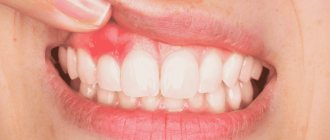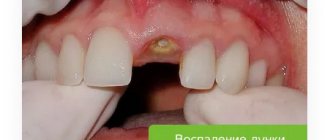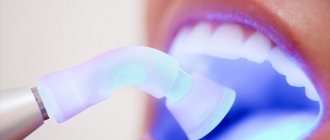Flux is one of the most unpleasant phenomena in dental practice. It is a growth with purulent contents located on the gum. The tumor is formed due to inflammation of the periosteum. As a rule, it occurs against the background of advanced dental diseases.
Did flux form after installing the filling? Are your gums swollen and painful? In this case, you should contact your doctor or another dentist as soon as possible. Do not delay your visit to a specialist to prevent the development of more serious complications.
Causes of dental periostitis
In dentistry, gumboil is commonly called periostitis of the jaw. According to statistics, this disease is diagnosed in approximately 5% of patients. In most cases, the infectious-inflammatory process affects the lower jaw and occurs in an acute form.
Periostitis can be provoked by:
- chronic periodontitis - prolonged inflammation of the periodontal tissues,
- alveolitis - infection of the socket after tooth extraction,
- jaw cyst is a benign neoplasm with liquid contents,
- complicated wisdom tooth eruption,
- mechanical damage to the jaw,
- sore throat, flu, acute respiratory viral infections,
- dentist mistakes when cleaning tooth canals and filling.
After installing a filling, flux may form due to hidden inflammation. When a toothache occurs, many patients take painkillers rather than see a doctor. Tablets eliminate pain, but not its cause.
Causes of cheek swelling
- First of all, a swollen cheek is a result of the treatment itself. The swelling normally goes away within a few hours after a visit to the dentist.
- A swollen cheek is often a consequence of the anesthetic used. This indicates that the patient is allergic to the drug administered to him. The patient may experience slight itching and pain in the area where the injection was given.
- Swelling of the cheek is a consequence of dental canal treatment. Sometimes during treatment, the drug penetrates the mucous membrane, which causes inflammation. As a rule, the doctor notices the swelling and takes action in the dental office. But such a situation in itself arises extremely rarely.
- Most often, a patient observes that his cheek is swollen after surgical tooth extraction. This is normal, since when a tooth is removed from its socket, blood vessels rupture. Violation of the integrity of the blood vessels leads to the fact that the cheek swells a little. The doctor must warn the patient about the consequences before the removal procedure. After the procedure, the dentist gives recommendations to the patient that help relieve swelling of the cheek and reduce pain. The condition returns to normal within 4-5 hours.
- The cause of cheek inflammation may be unsterile instruments used during treatment. The inflamed condition in this case is the result of infection entering the treated tooth. This can lead to inflammation of the airways and alveolitis.
If inflammation in the cheek does not go away within 2-3 days, be sure to consult a doctor. The sooner you contact your dentist, the faster he will eliminate the cause of the swelling and prevent serious consequences, such as gum suppuration. If pus has already formed, the dental surgeon will make an incision to eliminate the source of inflammation.
Clinical picture
A clear sign of gumboil is a lump on the gum with purulent contents. Before its formation, the disease makes itself felt by throbbing pain in the tooth. Symptoms of the pathology are also:
- swelling and redness of the gums,
- swelling of the cheek or lip,
- enlarged lymph nodes,
- pain when opening the mouth and swallowing,
- discomfort when pressing on a tooth,
- increase in body temperature,
- excessive weakness
- decreased appetite.
If you detect at least one of the listed signs of flux, you should contact the dentist. You should not warm the sore spot with a warm compress, take antibiotics without a doctor’s prescription, or open an abscess at home.
Should I see a doctor if I have pain after root canal cleaning?
Root canal cleaning is a surgical procedure that is performed when infection occurs and inflammation develops. Most often it is performed for pulpitis or periodontitis. This affects the soft tissues of the oral cavity. It should be borne in mind that in this case, already inflamed tissues are treated, and after cleaning, the inflammation persists for several days.
Therefore, a slight aching pain after therapy is normal and is not considered a cause for concern. At night, the pain often intensifies.
After a couple of days, the healing process enters an active phase, the pain slowly and gradually decreases, although pain and discomfort may persist for several weeks. They can be reduced or eliminated through anesthetic medications and rinses.
The pain syndrome can persist for a long time if the patient delays visiting the dentist, as a result of which the inflammation has become extensive and severe. Therefore, it is so important to regularly visit a specialist, undergo preventive examinations and visit a doctor at the first signs of illness. The sooner the problem is detected, the less complex and painful the therapy and rehabilitation will be.
Diagnosis and treatment
To make a diagnosis, the doctor only needs to examine the oral cavity and study an X-ray of the jaw. The flux treatment regimen is compiled individually for each patient. This may include:
- complex treatment of caries, pulpitis or periodontitis,
- taking antibacterial drugs,
- opening the abscess and draining the contents,
- rinsing the mouth with antiseptic solutions,
- physiotherapy - UHF, laser therapy, electrophoresis.
What could be the reason?
1. Individual reaction of the body to root canal treatment,
2. Inaccuracies in medical work.
And if your body’s physiological response to medical intervention is almost impossible to predict, all that remains is to focus on reducing potential risks during root canal treatment.
High-quality root canal treatment – what is it?
Yes, endodontic treatment (root canal treatment) is a rather complex dental procedure. To perform it well, you need precise manual skills of a doctor, an understanding of the mechanisms of pulpitis and periodontitis, and most importantly, compliance with protocols and treatment techniques.
Causes of pain after root canal filling
Principle No. 1 - sterility
One of the key principles in root canal treatment is to achieve relative sterility in the tooth canals. There is no way to completely get rid of microorganisms, but a doctor is quite capable of reducing the number of bacteria to the minimum level that the immune system can cope with.
To ensure sterility in the root canals, the dentist uses a rubber dam, this is a special latex scarf. Using a rubber dam, the doctor isolates the desired tooth from the rest of the mouth, which prevents saliva and bacteria from entering the root canals.
And to destroy bacteria that are already inside the root canals, the dentist repeatedly rinses the canals with sodium hypochlorite.
Principle No. 2 – full channel processing
In order to seal the canals and even to thoroughly rinse them with an antiseptic solution, you must first go through each canal for its entire length. Then, give the channels the required shape and expand them to the optimal size. For this purpose, the dentist-therapist has special tools in his arsenal, similar to thin flexible needles. They can be manual or machine. The best result is obtained by their combination.
Principles in root canal treatment
When treating root canals, KANO clinics use the X-SMART Plus endodontic micromotor and the Endo-Mate TC2 endodontic micromotor. This helps the doctor to process the canals quickly and reliably - because sodium hypochlorite does not get into the under-expanded root canals and bacteria can remain there. A tooth full of microorganisms is doomed to bother you again over time - and even cause removal with subsequent implantation.
Principle No. 3 – control of treatment at all stages
When performing root canal treatment, the dentist can only see the mouth - the very beginning of the root canal. And the rest of the canals are hidden from view inside the tooth root. Therefore, visualization tools play a special role in endotherapy: an X-ray machine and an apex locator.
1. X-ray control should be carried out before, after and during root canal treatment. Don't worry - you won't receive excessive radiation exposure, because during targeted images the radiation dose is very small (1.5-3.3 mSv).
2. Use of an apex locator - a special device for determining the length of the root canal during treatment. This allows the dentist to work only in the dental canal, without going into the peri-root tissue, and to minimize the patient’s pain - both during and after treatment.
Tooth hurts after root canal filling: what not to do
If the doctor controls the canal treatment process and does not work blindly, then the likelihood of post-filling pain is reduced significantly.
What not to do if your tooth hurts after root canal filling:
- Do not heat the tooth or steam it with hot water.
- You cannot cool an aching tooth or keep ice near it.
- Do not apply propolis, cotton wool soaked in essential oils, valocordin or any other substance to the tooth. Unfortunately, you can read about such methods on the Internet, but you absolutely cannot do this: at best there will be no effect, and at worst, you will have a burn to the mucous membrane.
- You should not try to open a temporary or permanent filling yourself.
Tooth hurts after root canal filling: what to do
Brief conclusions
The main consequences of poor treatment of pulpitis are as follows:
- flux, formation of cysts in cases where the canals are not completely filled, periodontitis;
- prolonged pain and neuralgia during repeated canal filling.
One of the most unpleasant consequences for the patient is tooth extraction. It cannot be avoided if:
- the doctor during the treatment broke the root or caused a perforation, which was not eliminated as soon as possible;
- A periodontal abscess formed at the root apex, and the patient delayed its treatment.
Tooth hurts after pulpitis treatment due to injured tissue near the root
The first stage of treatment for pulpitis is the removal of the inflamed pulp, after which the canals are sealed so that subsequently the inflammatory process does not begin to develop in them again. During the procedure, minor tissue trauma occurs, which simply cannot be avoided.
Pain may occur due to:
- separation of a bundle of nerves located near the upper part of the root, which often occurs when removing pulp;
- mechanical treatment of the canals with special tools (very often the tool can extend beyond the canal, causing injury to the tissues located near the apex of the tooth root);
- penetration of antiseptic agents used to flush the canals outside of them, which can cause irritation.
In all of the above cases, pain is a natural reaction of the body. After proper treatment, pain will stop within a maximum of 3 days.









